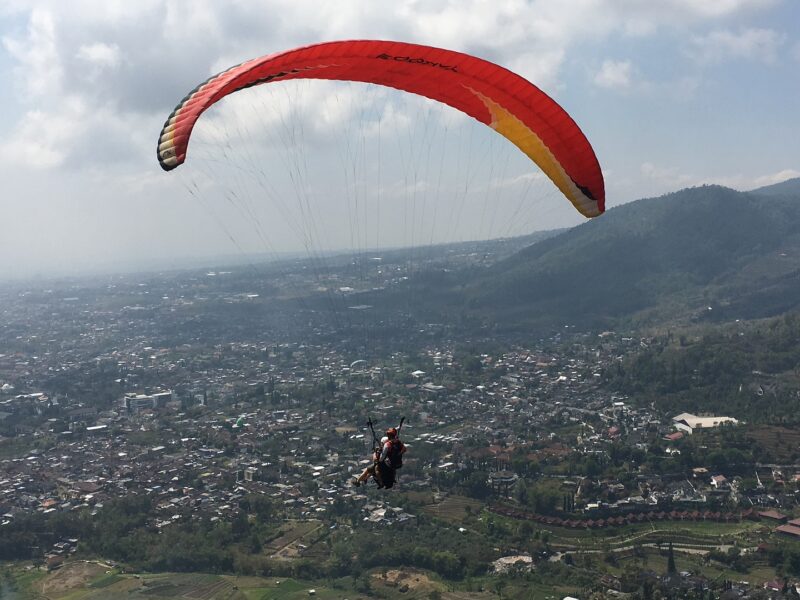Kuala Kangsar: A Hidden Gem Steeped in History and Tradition
Nestled along the banks of the Perak River, Kuala Kangsar is not just a picturesque town in Malaysia—it’s a treasure trove of history and tradition. This charming town serves as a living museum, showcasing centuries-old crafts like keris-making, a traditional Malay dagger, and exquisite pottery that continues to thrive among local artisans. The tranquil ambiance of Kuala Kangsar, coupled with its impeccably preserved historical sites, makes it a must-visit for anyone interested in the rich cultural tapestry of Malaysia.
The town’s name, Kuala Kangsar, is believed to have evolved from ‘Kuala Karong-Sa,’ which translates to ’99 small tributaries flowing into the Perak River’. This unique origin story adds a mystical allure to the town, inviting visitors to explore the numerous streams that once defined its landscape. Whether you’re a history buff, culture enthusiast, or simply in search of a peaceful retreat, Kuala Kangsar offers a glimpse into the soul of Malaysia, preserved through time in its architecture and ongoing traditions.
9 Best Kuala Kangsar Attractions
Kuala Kangsar is renowned for housing some of the most striking architectural feats in Malaysia. As you plan your visit, consider exploring these top destinations that highlight the grandeur and historical significance of the area. Each site offers a unique glimpse into the rich cultural heritage and exquisite design that Kuala Kangsar is celebrated for. From royal palaces to historic mosques, this guide will help you uncover the most captivating sights in one of Malaysia’s most picturesque towns. Whether you’re an architecture enthusiast or simply looking to enrich your travel experience with some historical context, Kuala Kangsar has a wealth of attractions that are sure to impress and inspire.
1. Ubudiah Mosque
Exploring Ubudiah Mosque: A Jewel of Kuala Kangsar
The Ubudiah Mosque stands as the crown jewel of Kuala Kangsar, embodying the grandeur and spiritual significance of this Malaysian town. Known as one of the most beautiful mosques in the country, its golden domes and elegant minarets are set against a backdrop of lush coconut palms, offering a mesmerizing view that captivates visitors.
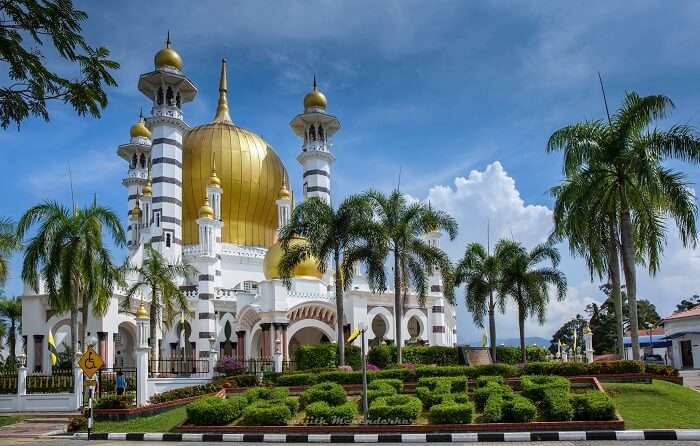
Designed by the renowned British architect Arthur Benison Hubback, the mosque’s construction began in 1913 at the behest of Sultan Idris Murshidul Adzam Shah. Despite initial setbacks, including a memorable incident where two royal elephants disrupted the site by damaging the Italian marble, the mosque was completed in 1917. This tale adds a unique historical layer to the mosque’s already rich narrative.
Today, the Ubudiah Mosque is not only a pivotal place of worship but also a must-visit landmark for those traveling through Malaysia. Located on Jalan Istana, this architectural masterpiece invites visitors to explore its intricate design and serene surroundings, making it a top attraction in Kuala Kangsar that reflects the town’s royal heritage and artistic prowess
Location: Jalan Istana, 33000 Kuala Kangsar, Negeri Perak, Malaysia
2. Istana Kenangan: The Royal Museum
Istana Kenangan: A Glimpse into Royal History at the Royal Museum
Once a royal residence, Istana Kenangan now stands as the Royal Museum of Perak, offering a fascinating window into Malaysia’s regal heritage. This stunning structure showcases exquisite craftsmanship, evident in the intricately carved roof and walls adorned in striking yellow and white hues. The building is a testament to traditional Malay architecture, reflecting a bygone era with meticulous attention to detail.
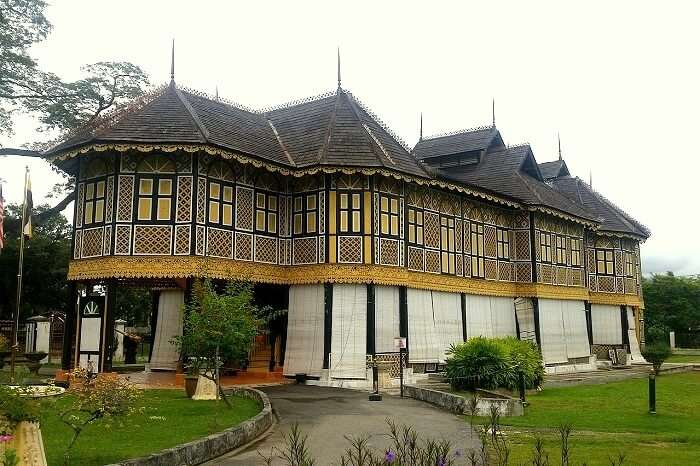
What makes Istana Kenangan truly remarkable is that its construction was accomplished without any blueprint, and not a single nail was used. Instead, the builders relied on traditional joinery techniques that have held up over time, showcasing the ingenuity of Malay artisans. Today, the museum welcomes visitors daily from 9:30 am to 5:00 pm, allowing both locals and tourists to explore its historical treasures.
Located in Kuala Kangsar, Istana Kenangan provides a unique opportunity to delve into Malaysia’s royal past while appreciating the architectural marvels of the region.
3. Istana Iskandariah: The Royal Palace
Istana Iskandariah, the majestic royal palace and the official residence of the Sultan of Perak, stands as a remarkable symbol of regality and heritage in Kuala Kangsar, Malaysia. Completed in 1933, this stunning edifice is noted for its architectural design inspired by West Asian influences, showcasing an elegant fusion of cultural aesthetics.
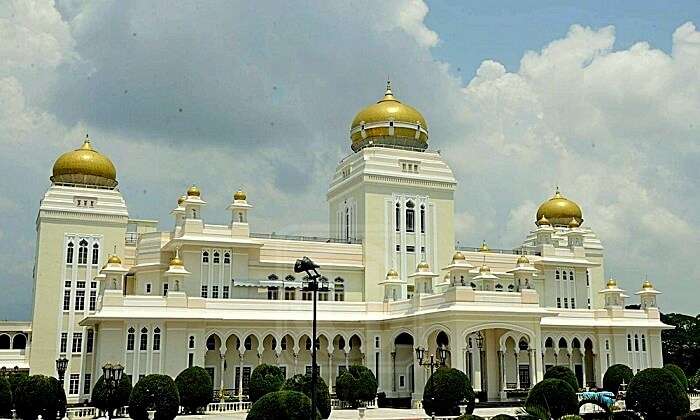
The palace is strategically positioned to face the sunrise and the flowing river, creating breathtaking views that enhance its serene ambiance. Architectural features such as onion-shaped domes and sleek minarets add to its distinguished appearance, making Istana Iskandariah a captivating sight.
Visitors to the palace can expect to be enchanted by its well-appointed interiors, which include a royal dining room, various audience halls, rest chambers reserved for royalty, a ladies’ cloakroom, a music hall, and the royal council chamber. Each space within the palace is meticulously designed, reflecting the opulent lifestyle and sophisticated taste of the Malaysian royalty.
Although Istana Iskandariah is not typically open to the public, its architectural grandeur can be admired from its surroundings, making it a must-visit landmark for anyone exploring the rich cultural tapestry of Kuala Kangsar. Located in Taman Lerista, this iconic palace is not just a residence but a piece of living history that continues to awe and inspire.
4. Sultan Azlan Shah Gallery
Nestled in the charming town of Kuala Kangsar in Perak, the Sultan Azlan Shah Gallery is not just a museum—it’s a gateway to the regal heritage of Malaysia. This majestic gallery is housed in a stunning building that once served as a palace, offering visitors a unique glimpse into the life and legacy of Sultan Azlan Shah, a revered figure in Malaysian history.
A Royal Legacy Displayed
The Sultan Azlan Shah Gallery does more than just recount the life of a royal; it immerses you in his world. The exhibits are meticulously curated to showcase significant milestones from Sultan Azlan Shah’s life, including his educational pursuits, distinguished career, and his profound love for hockey—a sport he passionately supported. Each artifact, whether it’s his academic robes or the hockey sticks he used, tells a story of a life lived with zeal and a deep commitment to his nation.
A Collector’s Paradise
Beyond his public life, Sultan Azlan Shah was known for his eclectic hobbies. The gallery features an impressive collection of coins, banknotes, and watches, each piece carefully selected by the Sultan himself. These collections are more than just hobbies; they are windows into the personal tastes and interests of a man who valued history and craftsmanship.
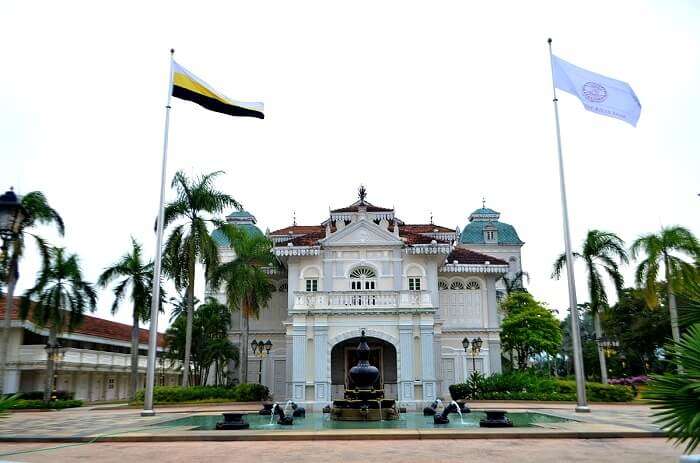
The Regalia and Attire
Perhaps one of the most striking features of the gallery is the display of Sultan Azlan Shah’s regalia. The collection includes various outfits, from ceremonial garbs to formal attire, each embroidered with intricate designs, showcasing the exquisite artistry of Malaysian culture. The swords displayed alongside the outfits are finely crafted, each bearing unique decorations that symbolize power and dignity.
Plan Your Visit
Located at 33000 Kuala Kangsar, Perak, the Sultan Azlan Shah Gallery is easily accessible and a must-visit for anyone interested in the rich tapestry of Malaysia’s royal heritage. The gallery not only offers a profound insight into the life of Sultan Azlan Shah but also serves as an educational hub that highlights the cultural and historical magnificence of Malaysia.
Whether you’re a history enthusiast, a lover of royal stories, or simply curious about the diverse cultures of the world, the Sultan Azlan Shah Gallery promises a captivating experience. Its comprehensive exhibits and beautiful setting provide a perfect backdrop to learn about the grandeur of Malaysia’s monarchy and the personal story of a Sultan who left a lasting mark on his country
5. Victoria Bridge
Located in the serene town of Enggor, the Victoria Bridge stands as a magnificent testament to Malaysia’s colonial past and architectural prowess. Constructed between 1897 and 1900, this bridge is not merely a structure but a piece of history that offers a glimpse into the bygone era of steam locomotives and grand colonial engineering.
A Bridge Through Time
Victoria Bridge, named in honor of Queen Victoria, was inaugurated by Sultan Idris Murshidul Azzam Shah, marking a significant moment in the history of Perak’s infrastructure development. Designed primarily for railway transport, it majestically spans the Perak River at Karai, a sight that evokes the charm of old classic films where steam engines chugged through remote landscapes.
Architectural and Historical Significance
The construction of Victoria Bridge marked a pivotal development in the modernization of Malaysia’s transportation network during the British colonial period. The bridge’s design reflects the engineering techniques of the time, characterized by its robust, yet elegant structure. Despite being decommissioned in 2002, the bridge remains a proud symbol of the technological advancement of its era and serves as a fascinating destination for those interested in the evolution of railway infrastructure.
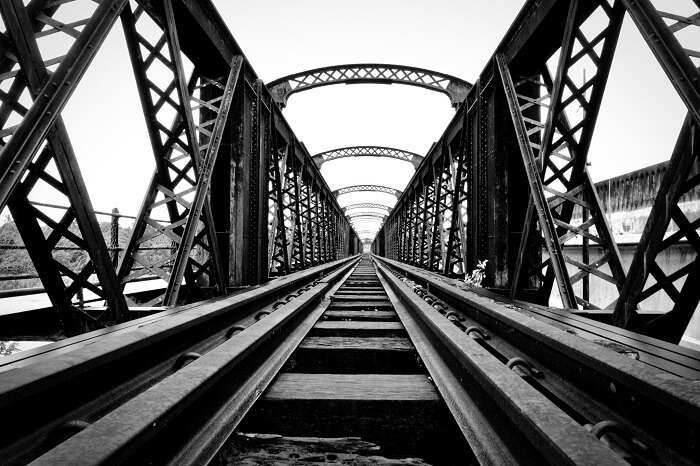
A Visit to Remember
Today, while trains no longer traverse its length, Victoria Bridge remains a compelling attraction for photographers, history buffs, and anyone intrigued by Malaysia’s rich cultural tapestry. Its location offers stunning views of the Perak River, making it a perfect spot for a peaceful afternoon of reflection or a picturesque sunset evening.
Getting There
Situated in Kampong Kapor, 31050 Enggor, Perak, Victoria Bridge is easily accessible and offers a journey as scenic as the destination itself. Visitors can enjoy nearby attractions and engage with the local community, gaining insights into the area’s unique cultural and historical context.
Whether you’re an avid historian eager to explore Malaysia’s colonial past, a photography enthusiast in search of the perfect landscape, or a traveler looking to uncover hidden gems, Victoria Bridge offers a unique blend of beauty, history, and tranquility. It stands not just as a relic of the past but as a beacon for those who appreciate the enduring legacy of human ingenuity and the quiet beauty of Perak.
6. Pavilion Square Tower
Nestled in the heart of Kuala Kangsar, Pavilion Square Tower stands as a remarkable emblem of Malaysia’s rich heritage and royal traditions. Located strategically across from the prestigious Malay College Malaysia on Jalan Tun Razak, this architectural marvel offers a unique blend of history, culture, and serene parkland surroundings.
A Royal Retreat with Historical Charm
Built in 1930 under the directive of Sultan Iskandar Shah, Pavilion Square Tower was originally designed as an exclusive vantage point for the royal family to enjoy polo matches. This three-tiered structure, with its elegant façade and panoramic views, provided a luxurious escape where royalty could revel in the sport in utmost comfort. Its historical use extends beyond leisurely afternoons watching polo; it also served as a recreational hub for court officials, adding layers to its rich historical tapestry.
Architectural Wonder and Cultural Icon
Often referred to as the “Pagoda of Malaysia” due to its distinctive style that mimics the tiered, ornate design typical of pagodas, Pavilion Square Tower is a fusion of local architectural elements and colonial influences. The building’s design is both a tribute to Malaysian cultural identity and a reflection of the historical influences that shaped the nation’s architectural landscape.
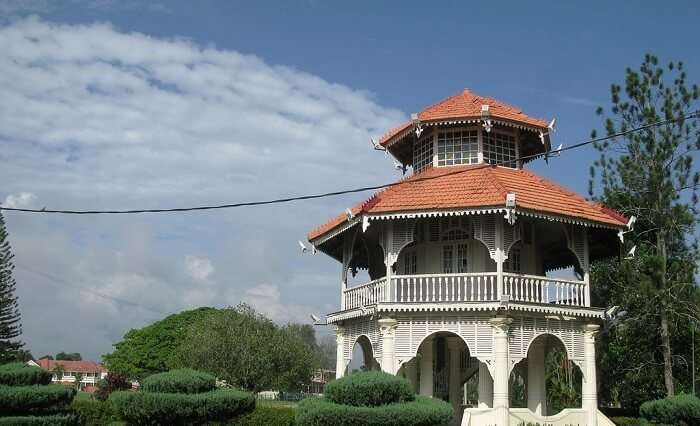
A Modern Transformation into Public Space
Following a thoughtful renovation, Pavilion Square Tower was integrated into the surrounding public park, transforming it into a space of relaxation and cultural engagement for both locals and tourists. Visitors can explore the tower, experiencing the grandeur of its original purpose while enjoying the tranquil greenery of the park that encircles it.
Visiting Pavilion Square Tower
Located at Jalan Tun Razak, 33000 Kuala Kangsar, Negeri Perak, Malaysia, the tower is easily accessible and makes for a perfect addition to any travel itinerary in Kuala Kangsar. It is more than just a historical site; it is a place where visitors can immerse themselves in Malaysia’s royal legacy, appreciate architectural beauty, and unwind in the peaceful park settings.
Whether you are a history enthusiast eager to explore the royal past of Malaysia, an architecture aficionado, or a traveler seeking a quiet retreat from the bustling city life, Pavilion Square Tower offers a captivating experience. It stands as a testament to the rich cultural fabric of Malaysia, inviting everyone to delve into its storied past and enjoy the serene landscape it now oversees.
7. Baitul Anor
Nestled in the heart of Perak, Baitul Anor stands as a testament to the opulent lifestyle and romantic stories of Malaysia’s royal lineage. Once the cherished residence of Raja Kechil Sulong Harun Al Rashid, a prince renowned for his significant role in Perak’s regal history, this mansion is not merely a structure but a repository of royal tales and traditions.
A Royal Residence with a Personal Touch
Built specifically for his third wife, Baitul Anor was designed to be a sanctuary of love and luxury. The mansion’s architecture reflects a deep appreciation for aesthetic detail and comfort, making it a notable landmark within the royal family’s expansive estate. Its distinctive yellow balcony, an architectural highlight, offers more than just a splash of color; it provides a panoramic view of the lush surroundings, symbolizing the elevated status and isolation often associated with royalty.
Inside Baitul Anor: A Glimpse into Royal Life
Stepping inside Baitul Anor is like traversing through a portal into the past. The mansion is adorned with an array of old photographs and cherished artifacts that chronicle the lives and times of Perak’s royal family. Each room tells a story, decorated with items that speak to the personal tastes and preferences of the royals who once lived there. The presence of intimate possessions, such as handwritten letters and personal diaries, adds a touch of authenticity and emotional depth to the visitor experience.
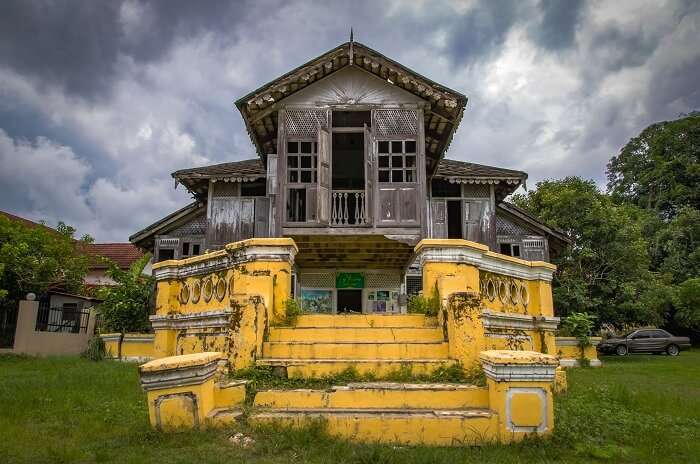
An Icon of Cultural Heritage
Baitul Anor serves not only as a historical site but also as an educational resource that offers insights into the cultural and social dynamics of Malaysian royalty. The stories embedded within its walls provide a unique perspective on the responsibilities, pleasures, and challenges faced by those born into royalty, making it a must-visit for anyone interested in the sociology of aristocracy.
Visiting Baitul Anor
For travelers and history buffs looking to delve into the rich tapestry of Malaysia’s royal heritage, a visit to Baitul Anor is highly recommended. Located within easy reach of local amenities, this mansion provides an enriching educational experience that complements the scenic beauty and historical significance of Perak.
Baitul Anor is more than just a building; it’s a piece of living history that offers a window into the life of a prince and his family. It stands as a beacon for those who seek to understand the nuances of Malaysian royalty and the architectural elegance of a bygone era. Whether you are a history enthusiast, an architecture lover, or simply curious about the lifestyles of the royal families of Malaysia, Baitul Anor offers a compelling and informative journey into the heart of Perak’s aristocratic past.
8. Iskandariah Bridge
In the picturesque town of Kuala Kangsar, the Iskandariah Bridge, also known as Sultan Iskandar Bridge, stands as a testament to architectural and engineering prowess. As one of the four major bridges that adorn the landscape of this royal town, Iskandariah Bridge is not only the longest steel arch bridge in Malaysia but also a symbol of progress and historical significance.
Engineering Excellence on Display
Spanning a majestic 308 meters in length and 10.2 meters in width, Iskandariah Bridge showcases the ingenuity of early 20th-century engineering. Constructed in 1932 by Messrs James Craig Ltd., the bridge’s steel arch design offers both aesthetic appeal and structural durability, making it a standout feature in the region. Its construction was a monumental achievement at the time, reflecting the technological advancements of the era.
A Royal Inauguration
The bridge’s importance is underscored by its royal inauguration by the late Almarhum Sultan Iskandar of Perak, after whom it was named. This event marked it as a cornerstone of Perak’s infrastructure and a proud emblem of the state’s development. The Iskandariah Bridge has since played a vital role in connecting communities and fostering economic growth in the area.
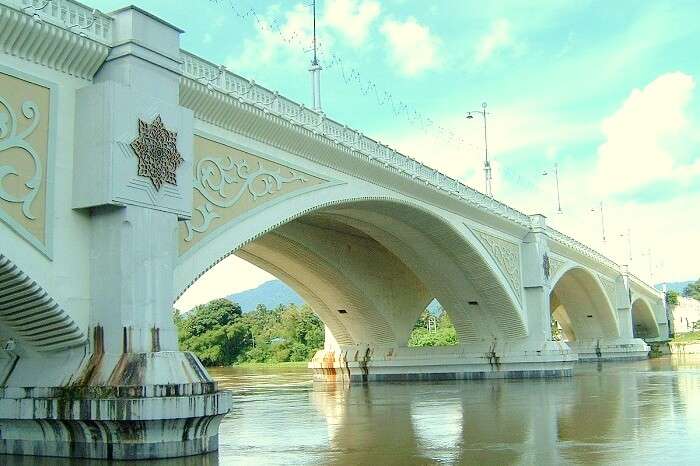
A Key Tourist Attraction
Today, the Iskandariah Bridge is not just a functional roadway; it’s a significant tourist attraction in Kuala Kangsar. Visitors are drawn to its historical relevance and engineering marvel, making it a popular spot for photographers, history enthusiasts, and those simply enjoying the scenic views over the river it spans. The bridge provides a picturesque backdrop against the lush greenery of the surrounding landscapes, perfect for a leisurely drive or a peaceful stop on a journey through Malaysia.
Plan Your Visit
Located along Malaysia Federal Route 1, the bridge is easily accessible from various parts of Malaysia, making it a convenient stop for travelers exploring the country. Visitors to the Iskandariah Bridge can enjoy not only the bridge itself but also the rich cultural heritage of Kuala Kangsar, including nearby royal palaces, traditional crafts, and local cuisine.
Whether you are an engineering aficionado, a history buff, or simply in search of a picturesque location, Iskandariah Bridge offers a unique blend of beauty, history, and engineering intrigue. It stands as a proud reminder of Malaysia’s capacity for great feats of engineering and a symbol of its rich cultural heritage. A visit to this bridge offers more than just a view; it provides a deep connection to the historical and cultural narrative of Kuala Kangsar and Malaysia at large.
9. Rubber Trees
In the quaint town of Kuala Kangsar, visitors have the unique opportunity to step back in time and witness a living piece of agricultural history. The oldest rubber trees in Malaysia, located just outside the Land & District Office, stand as silent witnesses to the country’s transformation into a major agricultural powerhouse.
A Symbol of Economic Growth
Introduced to Malaysia in 1877, rubber quickly became one of the country’s most crucial economic drivers, catapulting it into a leading position in the global rubber industry. These historic trees in Kuala Kangsar are not merely botanical specimens; they are monuments to the inception of rubber cultivation in Malaysia. Planted during the very early days of the industry, they mark the beginning of what would become a major economic transformation for the nation.
A Must-Visit for Eco-Tourists and Historians
The rubber trees of Kuala Kangsar are a must-see for anyone interested in the ecological and economic history of Malaysia. These trees are among the first to be planted in the country, making them a vital part of the nation’s heritage. Visitors from around the world flock to this site, not only to see the towering trees but to understand the impact of rubber on Malaysia’s social and economic fabric.
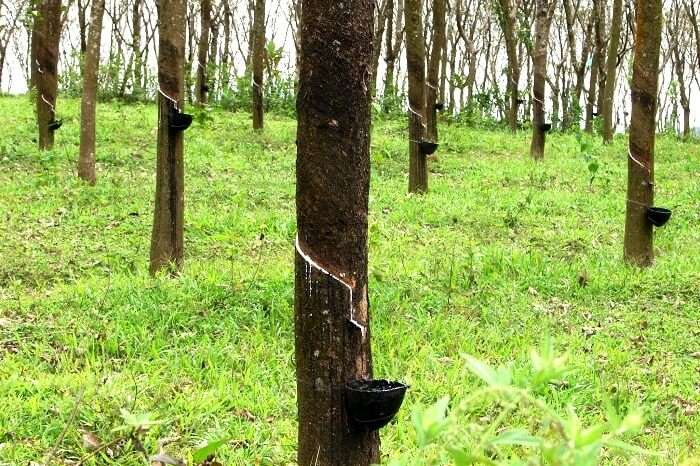
A Living Classroom
For educators, students, and anyone with a keen interest in agriculture or economic history, these trees provide a direct link to the past. The site serves as a living classroom, offering real-world insights into the challenges and triumphs of introducing a new crop to a region. Informational signage around the trees provides visitors with background on the rubber industry’s development and its significance to Malaysia.
Plan Your Visit
Situated conveniently outside the Land & District Office in Kuala Kangsar, the site is easily accessible and well-suited for a short visit. It provides a picturesque setting, ideal for those looking to escape the hustle and bustle of city life and enjoy a moment of tranquility under the shade of these monumental trees.
Whether you’re an environmental enthusiast, a history buff, or simply looking for a unique travel experience in Malaysia, a visit to the oldest rubber trees in Kuala Kangsar offers a fascinating glimpse into the nation’s past. It’s not just about observing these majestic trees; it’s about appreciating their contribution to the growth and development of Malaysia as we know it today.
FAQs for Must-Visit Kuala Kangsar Attractions
1. What are the top attractions to visit in Kuala Kangsar?
The top attractions in Kuala Kangsar include the Sultan Azlan Shah Gallery, the Iskandariah Bridge, Pavilion Square Tower, the Royal Museum of Perak, and the historic rubber trees. Each offers a unique glimpse into the cultural, historical, and natural beauty of the region.
2. Are there any entrance fees for the main attractions in Kuala Kangsar?
Most attractions in Kuala Kangsar, like the historic rubber trees and Iskandariah Bridge, are free to visit. Some museums and galleries, such as the Sultan Azlan Shah Gallery, may charge a small entrance fee. It’s advisable to check the latest information on their official websites or contact the venues directly.
3. What is the best time of year to visit Kuala Kangsar?
Kuala Kangsar can be visited year-round, but the best time to visit is during the dry season from June to August when the weather is most favorable for exploring the outdoors. The cooler months from November to February offer a pleasant climate as well, though there’s a higher chance of rain.
4. How long should I spend in Kuala Kangsar?
A one or two-day visit is sufficient to explore the major attractions in Kuala Kangsar. However, if you’re interested in a more relaxed pace or want to delve deeper into the local culture and surrounding areas, consider extending your stay to three days.
5. What are some lesser-known attractions in Kuala Kangsar that are worth visiting?
Beyond the well-known sites, Kuala Kangsar has several hidden gems like the Malay College, the Ubudiah Mosque, and the Kuala Kangsar Craft Centre where you can observe traditional Malaysian crafts being made. The nearby village of Labu Kubong, with its traditional Malay houses and lifestyle, offers an authentic cultural experience.
6. Is Kuala Kangsar suitable for family visits?
Absolutely! Kuala Kangsar offers a variety of attractions that are suitable for all ages. Children will enjoy exploring the royal museums, playing in the local parks, and learning about the history of the area in a fun and interactive way.
7. What are the best cultural experiences in Kuala Kangsar?
To immerse yourself in the local culture, attend a traditional Malay event or festival, visit the craft center to see artisans at work, or explore the local markets to try regional delicacies. The Ubudiah Mosque, with its stunning architecture, also offers insights into the Islamic cultural heritage of the area.
8. Are there guided tours available in Kuala Kangsar?
Yes, there are guided tours available that can take you through the historical and cultural landmarks of Kuala Kangsar. These tours often include insights and stories that you might miss when visiting on your own. Check local tour operators for offerings and schedules.
9. What are some tips for visiting Kuala Kangsar?
Wear comfortable walking shoes, as many attractions involve walking. Dress modestly, especially when visiting religious sites. Also, keep hydrated and bring sunscreen, as the Malaysian climate can be quite warm and sunny.
10. How do I get to Kuala Kangsar?
Kuala Kangsar is well-connected by road and is just a short drive from major cities like Kuala Lumpur and Penang. It is also accessible by train, with the Kuala Kangsar Railway Station located near the town center, making it convenient for travelers using public transport.

